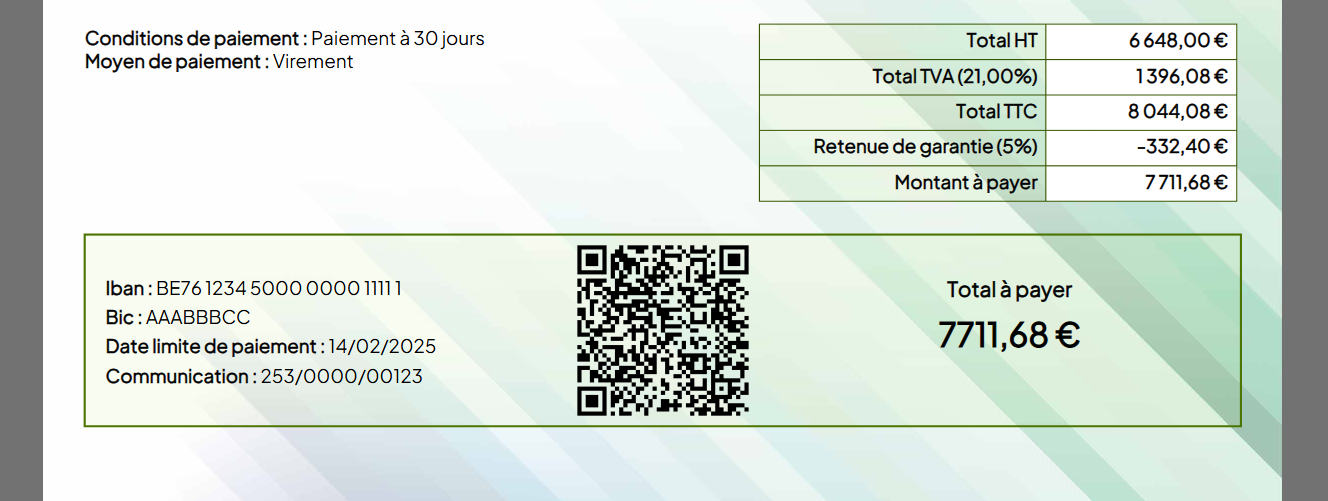Introduction to Retention Money
Retention money is a common practice in the construction and public works sectors in Belgium and Luxembourg. It secures completed work by providing for an amount withheld from payments to cover any defects or poor workmanship. Understanding how it works is essential for contractors and self-employed workers who want to optimize their financial management. Discover how the invoicing software Flexina, a reference in invoice management for SMEs and freelancers, facilitates retention money management.
What is Retention Money?
Retention money consists of withholding a percentage of the total amount of an invoice to guarantee the proper execution of work. This amount is released after a defined period, usually after provisional or final acceptance of the work.
In Belgium
- Usual percentage: 5% of the work amount.
- Retention duration: until final acceptance, often 12 months after provisional acceptance.
- Sectors concerned: mainly construction and public contracts.
- Legal obligations: Since January 1, 2009, companies must verify the solvency of their subcontractors to avoid social and tax debts.
In Luxembourg
- Usual percentage: between 5% and 10% depending on contracts.
- Retention duration: generally 1 year after work acceptance.
- Bank guarantee possible: Retention money can be replaced by a bank guarantee or one from a mutual guarantee fund.
How to Manage Retention Money with Flexina?
- Creating invoices with retention money: possibility to automatically integrate a retention percentage on your invoices.
- Adjustment of amount to be paid: Flexina automatically adjusts the total invoice amount to reflect the retention money.
- Invoice filtering: ability to easily filter invoices with retention money according to different criteria.
- Reminder automation: automatic sending of reminders to inform customers of remaining amounts due.

Frequently Asked Questions (FAQ) about Retention Money
1. What is retention money?
Retention money is a common financial mechanism in construction and service contracts. It consists of deducting a percentage of the total amount of work or services performed to cover any poor workmanship or non-compliance defects. This sum is generally returned at the end of the guarantee period, subject to repair of any defects.
2. In which sectors is retention money mandatory or recommended?
Retention money is mainly used in the construction, public works and public procurement sectors. It is often provided for by law or contracts to guarantee the proper execution of work.
3. What is the legal rate of retention money?
In Belgium and Luxembourg, the retention money rate is generally set at 5% of the total contract amount, unless otherwise specified in the contract. This rate can be adapted according to the clauses provided in the contract.
4. What is the duration of retention money?
The duration of retention money depends on the terms of the contract. In general, it varies between 1 and 2 years after provisional acceptance of the work.
5. What is the difference between retention money and a bank guarantee?
Retention money is an amount deducted directly from payments due to the service provider, while a bank guarantee is a guarantee provided by a bank, allowing the service provider to receive all of their payments. The bank guarantee can replace retention money if provided for in the contract.
6. How does Flexina manage retention money in its invoices?
Flexina facilitates retention money management by automating its calculation and application on invoices. The user can define the retention rate, and Flexina automatically adjusts the invoiced amounts to reflect this deduction.
7. Is it possible to customize retention money rates with Flexina?
Yes, Flexina allows you to customize retention money rates according to business needs and contractual requirements. This flexibility ensures management compliant with current regulations.
8. What are the advantages of using Flexina for retention money management?
Flexina offers a simple and effective solution for managing retention money:
- Automatic calculation of retention money.
- Rate customization according to contracts.
- Easy tracking of retained amounts and their release.
- Compliance with legal obligations in Belgium and Luxembourg.
9. Flexina and electronic invoicing via the Peppol network
Flexina is compatible with the Peppol network, which is already mandatory for public contracts in Belgium and Luxembourg. From 2026, the use of Peppol will also become mandatory for all B2B transactions in Belgium and strongly recommended in Luxembourg. This integration allows sending and receiving secure electronic invoices compliant with European standards, including invoices with retention money. Flexina thus facilitates retention money management while respecting new invoicing obligations.
Conclusion
Retention money management is a major issue for construction professionals in Belgium and Luxembourg. Thanks to its advanced features, Flexina simplifies this management and allows contractors to focus on their business.
Try Flexina today and optimize your financial management!




